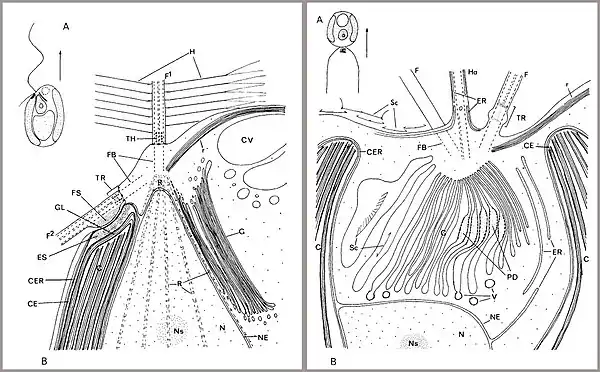Ultrastructural identity
Ultrastructural identity is a concept in biology that asserts that evolutionary lineages of eukaryotes in general and protists in particular could be distinguished by distinctive complements and arrangements of cellular organelles. These ultrastructural components were visualized by electron microscopy.

The concept emerged following the application of electron microscopy to protists. Such studies revealed that many previous groupings of protists based on light microscopy included organisms with very differing cellular organelles. Those groups included amoebae, flagellates, heliozoa, radiolaria, sporozoa, slime molds, and chromophytic alga. They were deemed likely to be polyphyletic, and their inclusion in efforts to assemble a phylogentioc tree would cause confusion. As an example of this work, the German cell biologist Christian Bardele established unexpected diversity with the simply organized heliozoa,.[1][2][3][4] Because of his work it became evident that the heliozoa were composed of seven types of organisms: actinophryids, centrohelids, ciliophryids, desmothoracids, dimporphids, gymnosphaerids and taxopodids.[5]
The seminal step forward was made by British phycologist David Hibberd.[6] He demonstrated that two types of chromophytic algae, previously presumed to be closely related, had very different organizations as revelaed by electron-microscopy. The number and organization of locomotir organelles differed (chrysophyte - two flagella; haptophyte - two flagella and haponema), the surfaces of which differed (chrysophyte - with tripartite flagellar hairs now regarded as apomorphic for stramenopiles; haptophyte - naked), as did the transitional zone between axoneme and basal body (chrysophyte with helix); as did flagellar anchorage systems; presence or absence of embellishments on the cell surface (chrysophyte - naked; haptophyte - with scales), plastids especially eyespot, location and functions of dictyosomes, inter alia. This careful study prompted further examination of algal and flagellate organization. European protozoologists Guy Brugerolle and David Patterson were the first to use the term ‘ultrastructural identity’ in discussing the differences between ciliates and a looaklike protist, Stephanopogon.[7] Patterson later applied the concept to all eukaryotes, rendering their diversity into a inventory of 71 types, each without clear sister group affinities (.[8] A further 200 or so genera that had not yet been studied by electron microscopy were added.
An indirect benefit of the focus on ultrastructural characters was that it allowed synapomorphies to be identified for emerging lineages. American molecular protistology, John Gunderson and colleagues established that dinoflagellates apicomplexa, and ciliates wre likely related.[9] They, and some related flagellates, were shown to share a distinctive system of sacs or alveoli under the cell membrane, and because of this were given the name ‘Alveolates’. Similarly, tripartite tubular hairs attached to various algae, fungi and protozoa provided the synapomorphy for the ‘stramenopiles’ (straw-hairs)[10] A distinctive flagellar root system that caused grooving on ther cell surface was also treated as a synapomorphy of the excavate flagellates [11]
References
- Bardele, C. F. 1972. Cell cycle, morphogenesis, and ultrastructure in the pseudoheliozoan Clathrulina elegans. Zeitschrift für Zellforschung 130:219–242
- Bardele, C. F. 1975 The fine structure of the centrohelidian heliozoan Heterophrys marina. Cell Tiss. Res, 161: 85-102
- Bardele, C. F. 1977. Comparative study of axopodial microtubule patterns and possible mechanisms of pattern control in the centrohelidian heliozoa Acanthocystis, Raphidiophrys and Heterophrys. J. Cell Sci. 25, 205-23
- Bardele, C. F. 1977. Organization and control of microtubule pattern in centrohelidian heliozoa. J. Protozool. 24, 9-14
- Smith, R. McK., and Patterson, D.J. 1986. Analyses of heliozoan interrelationships: an example of the potentials and limitations of ultrastructural approaches to the study of protistan phylogeny. Proceedings of the Royal Society of London. Series B, Biological Sciences, 227: 325-366
- Hibberd, D. J. 1976. The ultrastructure and taxonomy of the Chrysophyceae and Prymnesiophyceae (Haptophyceae): a survey with some new observations on the ultra-structure of the Chrysophyceae. Botanical Journal of the Linnaean Society 72:55–80
- Patterson, D. J. & Brugerolle, G. 1988. The ultrastructural identity of Stephanopogon apogon and the relatedness of the genus to other kinds of protists. Europ. J. Protistol. 23: 279-290.
- Patterson, D. J. 1999. The diversity of eukaryotes. American Naturalist 154: S96-124
- Gajadhar, A. A., W. C. Marquardt, R. Hall, J. Gunderson, E. V. Ariztia-Carmona, and M. L. Sogin. 1991. Ribosomal RNA sequences of ‘’Sarcocystis muris’’, ‘’Theileria annulata’’ and ‘’Crypthecodinium cohnii’’ reveal evolutionary relationships among apicomplexans, dinoflagellates, and ciliates. Molecular and Biochemical Parasitology 45: 147–154
- Patterson, D. J. 1989. Stramenopiles: chromophytes from a protistological perspective. In: Green, J.C., Leadbeater, B.S.C. & Diver, W. L. 1989. The chromophyte algae: problems and perspectives. Clarendon Press, Oxford. 357-379.
- Simpson A. G. B. & Patterson, D. J. 1999. The ultrastructure of Carpediemonas membranifera: (Eukaryota), with reference to the 'excavate hypothesis'. European Journal of Protistology 35: 353-370